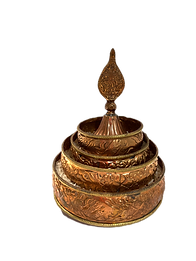1 CHENREZIG THANKHA
Chenrezig (Tibetan; Sanskrit: Avalokitesvara: Lord who looks down) is a bodhisattva (Sanskrit, person on the path to enlightenment for the benefit of all beings) seen as the embodiment of compassion, whose current manifestation is the 14th Dalai Lama. His mantra is Om Mani Pema Hung (Tibetan, Sanskrit: Om Mani Padme Hum). Om consists of three syllables, A-U-M, which refers to the Buddha's body, speech, and mind. Mani means jewel and symbolises our wishes (intentions) to remove obstacles to enlightenment. Pema (or padme) means lotus flower and points to the flower, which reaches out of the mud toward the sun. This light represents wisdom to reach enlightenment. Hung (hum) means union of wisdom and intention to reach purity of body, speech and mind.
2 KATA
Kata is a traditional offering scarf. It can be presented to a teacher or is often given to family or friends when departing or arriving from a trip or congratulatory event.
3 REFUGE TREE
Refuge Tree Is used as a visualisation aid when doing the preliminary practice of prostrations. It shows the lineage transmission of the practitioners' teachers, surrounded by depictions of the three jewels.
Refuge prayer (in Tibetan with English translation)
SAHNG GYAY CHO DANG TSO KYI CHO NAHM LA
In the Buddha, Dharma, and Supreme Community
JAHNG CHUB BAR DU DAHK NI KYAB SU CHEE
I take refuge from now until enlightenment
DHAK GHEE JIN SO GYEE PAY SO NAHM KYEE
By the merit of practicing generosity
DRO LAH PEN CHIR SAHNG GYAY DROOP PAR SHO
May I become a Buddha for the benefit of all beings.
4 BROCADE RUNNER with Om Mani Peme Hung, mantra of Chenrezig
5 GREEN TARA (gold colored statue)
Green Tara (Tibetan: Jetsun Droelma, meaning to save or liberate) is the embodiment of enlightened activity. The green colour represents enlightened activity, wisdom and compassion in action. Practitioners recite her mantra, Om Tare Tu Tare Ture Svaha (Sanskrit), for swift and precise attention. Her right leg is dangling in preparation for action to help. The earliest writings of Tara go back to the 5th-8th CE, where she is described as the goddess who is the compassion of Chenrezig. She is often described as a bodhisattva who came to life from a lotus flower where Chenrezig's compassionate tear fell when seeing the suffering of all beings.
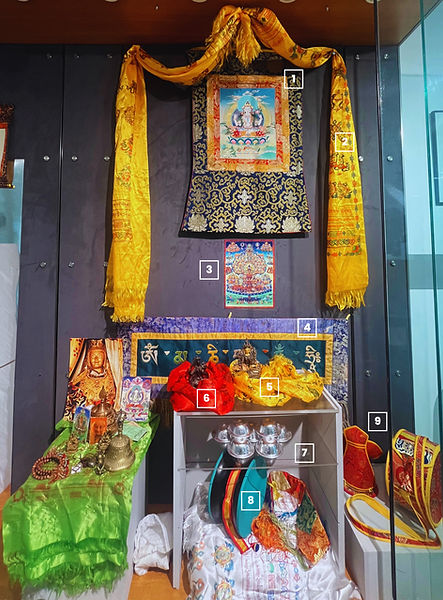
6 MANJUSHRI (wooden statue)
Manjushri is a male bodhisattva who is the embodiment of transcendent wisdom. He brandishes a sword in his right hand, which symbolises cutting ignorance and duality. In his left hand, he holds the scripture of the Prajnaparamita sutra, which sits in a lotus flower and represents his achievement of realisation through the blossoming of wisdom. His mantra is Om A Ra Pa tsa Na Dhih, and when chanted, it brings wisdom and improves academic skills such as debating and writing. Another popular mantra is Om Shri Di Ma Me Di Pam Manjushri Mum Ma Shri Praja Varda Da Ni Shri Di Soha.
7 OFFERING BOWLS
Offering Bowls called ting in Tibetan. There are always seven, and they are lined up from left to right. Each bowl should be the distance of one barley seed from the other. One fills them with water from left to right, adding a little as it is inauspicious to leave any empty and then returning to fill up. When filling, Buddhists recite a mantra, usually Om Mani Peme Hung. One usually visualises offering beautiful things and good qualities to all Buddhas. They are filled every morning and emptied each night, turning the empty bowls over and stacking them as displayed. As with all Tibetan Buddhist practices, once finished, the practitioner dedicates the merit earned to all sentient to alleviate suffering to all sentient beings.
8 DRUM
This drum (Tibetan: choeda, Nepali: damaru ) is used in a Tibetan Buddhist practice called choed – (Tibetan script: གཅོད), which means 'to sever'. Practised mainly by the Nyingma and Kagyu schools, it is used to confront the feeling of fear as a means to understanding the Buddhist tenet that all consists of 'emptiness', or the lack of inherent existence.
Jamgon Kongtrul (Buddhist scholar who lived 1813-1899) describes choed as" accepting willingly what is undesirable, throwing oneself defiantly into unpleasant circumstances, realising that gods and demons are one's own mind, and ruthlessly severing self-centred arrogance through an understanding of the sameness of self and others" (Powers 2007: 426).
Machig Labdroen (1055-1149 CE), a Tibetan Buddhist nun, is thought to be the originator of the practice.
Personal Practice
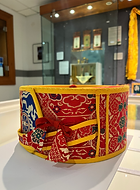
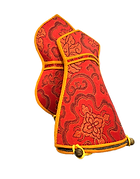
10 DORJE AND BELL These two objects are used together in many Tibetan Buddhist rituals. The DORJE (thunderbolt, noble stone; Sanskrit: vajra) and BELL (Sanskrit: ghanta; Tibetan: dril bu ) together represent enlightenment and display the non-dualistic nature of compassion (dorje) and bell (wisdom). The bell's hollow is where all phenomena arise; the clapper represents form, and the union of form and emptiness arises when the sound is created.
The five prongs of the dorje symbolise the five Buddha families and represent the five perfections of generosity, morality, patience, perseverance and concentration. The Tibetan letter HUNG is sealed in a small sphere at its centre, representing freedom from karma and conceptual thought.
11 PRECIOUS PILLS called rinchen ril bu or jewel pills in Tibetan are often distributed at large ceremonies, are blessed by the lama and are considered blessed by the Buddha. This medicine is likened to a blessing that enters the patient and aims to cure a diverse group of ailments. They may also be worn as amulets to protect the wearer from spirits. The pills are said to benefit the body and aid in spiritual development. They may consist of processed semi-precious stones such as turquoise, coral, and pearl, which the Tibetan physician has prepared. The preparation and efficacy involve reading sacred texts and following a strict and complex 'tradition' involving the pills, their composition, and socio-historical and religious values (Gerke 2019).
12 MANDALA This offering is built representing the entire universe and aims to accumulate merit to purify attachment. The practice is also one of the four preliminary practices, each traditionally repeated 100,000 times and aimed at preparing the practitioner for more advanced practices.
Through offering to all the Buddhas in their pure realms
The entire billionfold universe,
Adorned with all kinds of desirable gifts
The wisdom of Buddhahood is perfected.
Lobpoen Techchok Yeshe Dorje
13 COUNTER may be worn on a finger by some to count the preliminary practices, collectively called Ngondro. The four practices are: prostrations to take refuge in the three jewels, the Buddha, the dharma (the teachings), and the sangha ( the community) to purify pride; recitation of Vajrasattva ( Sanskrit: Diamond or Thunderbolt Being)mantra to purify aversion; mandala offering to purify attachment; and guru (teacher) yoga (meditation) to purify delusion.
14 MALA a string of 108 beads used more conventionally to count mantras or other practices done in repetition.
SMALL AND LARGER PICTURE CARDS AND STATUES Practitioners may carry these or place them on an altar when doing meditations or recitations.
15 CHENREZIG small statue on the right. Emanation of compassion
16 GREEN TARA statue on the left.Embodiment of enlightened activity.
17 DILGO KHYENSTE RINPOCHE was recognised as one of the most realised masters and lived from 1910-1991.
18 DRAWING OF MANJUSHRI (RED) manifestation of wisdom
20 DRAWING OF CHENREZIG Emanation of compassion.
21 PICTURE OF STATUE OF GURU RINPOCHE (Tibetan meaning precious master): He is also known as Padmasambhava ( Sanskrit: Lotus Born) and lived during the 8th century CE."Guru Rinpoche can be envisaged in a far broader perspective as being the marvellous manifestation of deepest truth within the commonly-perceived yet illusory world. As such, he can be considered in three main ways: as a generic name for emanations of Buddha (Sakyamuni), as the archetypal guru or as a historical figure". Ken Holmes
22 NECKLACES which have been blessed by lamas.
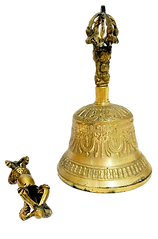
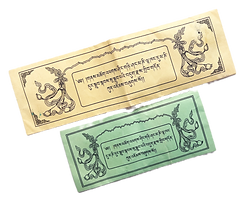
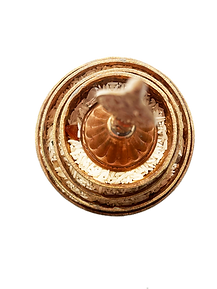

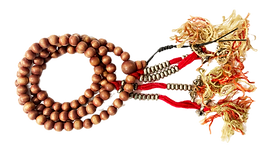
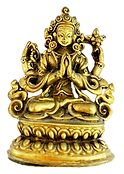
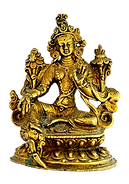
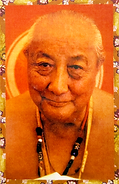
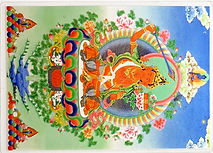
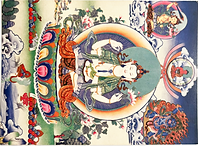
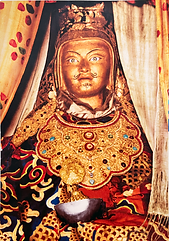
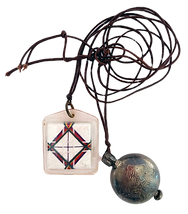
9 DRUM AND DORJE AND BELL CASES
